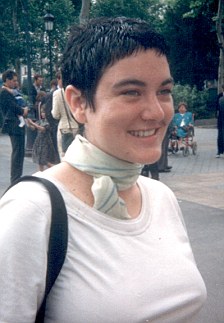Myalgic encephalomyelitis: Difference between revisions
(→Signs and Symptoms: alpha order and internal links) |
(lots of little changes) |
||
| Line 1: | Line 1: | ||
'''Myalgic Encephalomyelitis''' (ME) is a chronic, [[Inflammation|inflammatory]], physically and [[neurological|neurologically]] disabling disease that presents with symptoms involving multiple bodily systems. Frequently triggered by a [[viral infection]], it affects the [[central nervous system]] (CNS), [[autonomic nervous system]] (ANS), [[immune system]], [[cardiovascular system]], [[endocrine system]], [[digestive system]], and [[musculoskeletal system]].<ref name=":8">{{Cite news|url=https://rarediseases.org/rare-diseases/myalgic-encephalomyelitis/|title=Myalgic Encephalomyelitis - NORD (National Organization for Rare Disorders)|work=NORD (National Organization for Rare Disorders)|access-date=2018-09-07|language=en-US}}</ref><ref>{{Cite web|url=http://paradigmchange.me/wp-content/uploads/2016/04/ME-CFS-Medical-Abormalities-040416.pdf|title=Myalgic Encephalomyelitis (ME) and Chronic Fatigue Syndrome (CFS) Medical Abnormalities Research Citations|last=Petrison|first=Lisa|date=Apr 4, 2016|website=paradigmchange.me|archive-url=|archive-date=|dead-url=|access-date=}}</ref> It has been classified by the [[World Health Organization]] (WHO) as a neurological disease since 1969<ref>{{Cite journal|date=2018-07-22|title=History of chronic fatigue syndrome|url=https://en.wikipedia.org/w/index.php?title=History_of_chronic_fatigue_syndrome&oldid=851489536|journal=Wikipedia|language=en}}</ref><ref>{{Cite news|url=https://rarediseases.org/rare-diseases/myalgic-encephalomyelitis/|title=Myalgic Encephalomyelitis - NORD (National Organization for Rare Disorders)|work=NORD (National Organization for Rare Disorders)|access-date=2018-09-08|language=en-US}}</ref> and has occurred in both [[Epidemic myalgic encephalomyelitis|epidemic]] and sporadic forms since at least the 1930s. | '''Myalgic Encephalomyelitis''' (ME) is a progressive chronic, [[Inflammation|inflammatory]], physically and [[neurological|neurologically]] disabling disease that presents with symptoms involving multiple bodily systems. Frequently triggered by a [[viral infection]], it affects the [[central nervous system]] (CNS), [[autonomic nervous system]] (ANS), [[immune system]], [[cardiovascular system]], [[endocrine system]], [[digestive system]], and [[musculoskeletal system]].<ref name=":8">{{Cite news|url=https://rarediseases.org/rare-diseases/myalgic-encephalomyelitis/|title=Myalgic Encephalomyelitis - NORD (National Organization for Rare Disorders)|work=NORD (National Organization for Rare Disorders)|access-date=2018-09-07|language=en-US}}</ref><ref>{{Cite web|url=http://paradigmchange.me/wp-content/uploads/2016/04/ME-CFS-Medical-Abormalities-040416.pdf|title=Myalgic Encephalomyelitis (ME) and Chronic Fatigue Syndrome (CFS) Medical Abnormalities Research Citations|last=Petrison|first=Lisa|date=Apr 4, 2016|website=paradigmchange.me|archive-url=|archive-date=|dead-url=|access-date=}}</ref> It has been classified by the [[World Health Organization]] (WHO) as a neurological disease since 1969<ref>{{Cite journal|date=2018-07-22|title=History of chronic fatigue syndrome|url=https://en.wikipedia.org/w/index.php?title=History_of_chronic_fatigue_syndrome&oldid=851489536|journal=Wikipedia|language=en}}</ref><ref>{{Cite news|url=https://rarediseases.org/rare-diseases/myalgic-encephalomyelitis/|title=Myalgic Encephalomyelitis - NORD (National Organization for Rare Disorders)|work=NORD (National Organization for Rare Disorders)|access-date=2018-09-08|language=en-US}}</ref> and has occurred in both [[Epidemic myalgic encephalomyelitis|epidemic]] and sporadic forms since at least the 1930s. | ||
A hallmark symptom of ME is [[Post-exertional malaise|post-exertional malaise]] (PEM), which is an intolerance to previously achievable cognitive or physical [[exertion]].<ref name=":0">{{Cite news|url=https://prevention.nih.gov/programs-events/pathways-to-prevention/workshops/me-cfs|title=Pathways to Prevention (P2P) Advancing the Research on Myalgic Encephalomyelitis/Chronic Fatigue Syndrome (ME/CFS)|last=|first=|date=|work=Office of Disease Prevention|access-date=2018-09-07|archive-url=|archive-date=|dead-url=|language=en}}</ref><ref name=":1">[http://www.meactionuk.org.uk/definition.html Research Descriptions of M.E. - ME Action UK]</ref><ref name=":2">{{Cite web|url=http://www.cfids-me.org/ramsay86.html|title=The Clinical Features of Myalgic Encephalomyelitis|last=Ramsey|first=Melvin|date=1986|website=www.cfids-me.org|archive-url=|archive-date=|dead-url=|access-date=2018-09-07}}</ref><ref name=":3">{{Cite news|url=https://www.verywell.com/what-is-post-exertional-malaise-716023|title=What is Post-Exertional Malaise? Learn About a Key ME/CFS Symptom|last=Dellwo|first=Adrienne|date=Aug 1, 2018|work=Verywell Health|access-date=2018-09-07|archive-url=|archive-date=|dead-url=}}</ref><ref name=":5">{{Cite news|url=http://www.webmd.com/chronic-fatigue-syndrome/chronic-fatigue-syndrome-symptoms|title=Think You Might Have Chronic Fatigue Syndrome? Here are The Symptoms|work=WebMD|access-date=2018-09-07|language=en-US}}</ref><ref name=":6">{{Cite web|url=http://solvecfs.org/wp-content/uploads/2013/10/pem-series.pdf|title=Post-Exertional Malaise in Chronic Fatigue Syndrome|last=Spotila|first=Jennifer|date=2010|website=solvecfs.org|publisher=The CFIDS Association of America|archive-url=|archive-date=|dead-url=|access-date=}}</ref> Other key symptoms include [[muscle]] [[Muscle weakness|weakness]] and easy [[Muscle fatigability|fatiguability]], [[sleep disturbance]], and [[cognitive dysfunction]]. ANS dysfunction is frequent, although specific symptoms vary from patient to patient and may include [[Postural orthostatic tachycardia syndrome|postural orthostatic tachycardia]] (POTS), [[Orthostatic intolerance|orthostatic hypotension]] (OI), and both [[Body temperature|cold and heat intolerance]]. Other common symptoms include [[myalgia]] (muscle pain), [[neuralgia]] (neuropathic pain), [[Neck stiffness|neck]] and [[spine stiffness]], and sensory symptoms including [[sensitivity to light]], [[Hyperacusis|sound]], [[touch]], [[Paresthesia|paraesthesia]] (skin tingling or [[numbness]]) and hyperaesthesia (skin sensitivity and pain, and [[allodynia]]). | A hallmark symptom of ME is [[Post-exertional malaise|post-exertional malaise]] (PEM), which is an intolerance to previously achievable cognitive or physical [[exertion]].<ref name=":0">{{Cite news|url=https://prevention.nih.gov/programs-events/pathways-to-prevention/workshops/me-cfs|title=Pathways to Prevention (P2P) Advancing the Research on Myalgic Encephalomyelitis/Chronic Fatigue Syndrome (ME/CFS)|last=|first=|date=|work=Office of Disease Prevention|access-date=2018-09-07|archive-url=|archive-date=|dead-url=|language=en}}</ref><ref name=":1">[http://www.meactionuk.org.uk/definition.html Research Descriptions of M.E. - ME Action UK]</ref><ref name=":2">{{Cite web|url=http://www.cfids-me.org/ramsay86.html|title=The Clinical Features of Myalgic Encephalomyelitis|last=Ramsey|first=Melvin|date=1986|website=www.cfids-me.org|archive-url=|archive-date=|dead-url=|access-date=2018-09-07}}</ref><ref name=":3">{{Cite news|url=https://www.verywell.com/what-is-post-exertional-malaise-716023|title=What is Post-Exertional Malaise? Learn About a Key ME/CFS Symptom|last=Dellwo|first=Adrienne|date=Aug 1, 2018|work=Verywell Health|access-date=2018-09-07|archive-url=|archive-date=|dead-url=}}</ref><ref name=":5">{{Cite news|url=http://www.webmd.com/chronic-fatigue-syndrome/chronic-fatigue-syndrome-symptoms|title=Think You Might Have Chronic Fatigue Syndrome? Here are The Symptoms|work=WebMD|access-date=2018-09-07|language=en-US}}</ref><ref name=":6">{{Cite web|url=http://solvecfs.org/wp-content/uploads/2013/10/pem-series.pdf|title=Post-Exertional Malaise in Chronic Fatigue Syndrome|last=Spotila|first=Jennifer|date=2010|website=solvecfs.org|publisher=The CFIDS Association of America|archive-url=|archive-date=|dead-url=|access-date=}}</ref> Other key symptoms include [[muscle]] [[Muscle weakness|weakness]] and easy [[Muscle fatigability|fatiguability]], [[sleep disturbance]], and [[cognitive dysfunction]]. ANS dysfunction is frequent, although specific symptoms vary from patient to patient and may include [[Postural orthostatic tachycardia syndrome|postural orthostatic tachycardia]] (POTS), [[Orthostatic intolerance|orthostatic hypotension]] (OI), and both [[Body temperature|cold and heat intolerance]]. Other common symptoms include [[myalgia]] (muscle pain), [[neuralgia]] (neuropathic pain), [[Neck stiffness|neck]] and [[spine stiffness]], and sensory symptoms including [[sensitivity to light]], [[Hyperacusis|sound]], [[touch]], [[Paresthesia|paraesthesia]] (skin tingling or [[numbness]]) and hyperaesthesia (skin sensitivity and pain, and [[allodynia]]). | ||
| Line 21: | Line 21: | ||
{{Main article | page_name =History of myalgic encephalomyelitis and chronic fatigue syndrome}}<div role="note" class="hatnote navigation-not-searchable"> | {{Main article | page_name =History of myalgic encephalomyelitis and chronic fatigue syndrome}}<div role="note" class="hatnote navigation-not-searchable"> | ||
ME has occurred in both epidemic and sporadic form since at least the 1930s, although | ME has occurred in both epidemic and sporadic form since at least the 1930s, although it has likely been occurring much longer but was not formally named. The first recorded outbreak of [[epidemic myalgic encephalomyelitis]] was in [[1934 Los Angeles atypical polio outbreak|1934 in Los Angeles]] and was thought to be an outbreak of atypical [[polio]]. After the outbreak in [[Akureyri]], Iceland in 1946, the disease came to be called 'Akureyri Disease' or [[Icelandic disease]] through much of the 1940s and 1950s. It was named ME after London's [[Royal Free Hospital outbreak]] in 1955. Other names included benign myalgic encephalomyelitis and [[Epidemic myalgic encephalomyelitis|epidemic neuromyasthenia]]. | ||
After the [[1984 Incline Village chronic fatigue syndrome outbreak|Incline Village]] outbreak in Nevada in 1984, the disease came to be called and redefined as [[chronic fatigue syndrome]] (CFS). The most recent putative outbreak was in [[1996 Mohave Valley region, Arizona|Arizona in 1996]]. | After the [[1984 Incline Village chronic fatigue syndrome outbreak|Incline Village]] outbreak in Nevada in 1984, the disease came to be called and redefined as [[chronic fatigue syndrome]] (CFS). The most recent putative outbreak was in [[1996 Mohave Valley region, Arizona|Arizona in 1996]]. | ||
| Line 47: | Line 47: | ||
Following after an incubation period of 4 to 7 days, the [[wikipedia:Prodrome|prodromal]] phase generally involve a [[flu-like illness]] with [[low-grade fever]]. In the majority but not all cases, an [[infection]] or infectious process is evident.<ref>[http://www.nightingale.ca/documents/Nightingale_ME_Definition_en.pdf ME Definition - Nightingale - PDF pg. 6]</ref> Two to seven days later, a chronic phase commences, characterized by a measurable diffuse change in the function of the CNS. It is this second phase, persistent phase that most characterizes ME.<ref>{{Cite web|url=https://www.scribd.com/document/32848597/Nightingale-ME-Definition-En|title=Nightingale ME Definition En {{!}} Chronic Fatigue Syndrome {{!}} Infection|last=|first=|date=|website=Scribd|page=5|pages=|at=|language=en|archive-url=|archive-date=|dead-url=|access-date=2018-09-08}}</ref><ref name=":8" /> | Following after an incubation period of 4 to 7 days, the [[wikipedia:Prodrome|prodromal]] phase generally involve a [[flu-like illness]] with [[low-grade fever]]. In the majority but not all cases, an [[infection]] or infectious process is evident.<ref>[http://www.nightingale.ca/documents/Nightingale_ME_Definition_en.pdf ME Definition - Nightingale - PDF pg. 6]</ref> Two to seven days later, a chronic phase commences, characterized by a measurable diffuse change in the function of the CNS. It is this second phase, persistent phase that most characterizes ME.<ref>{{Cite web|url=https://www.scribd.com/document/32848597/Nightingale-ME-Definition-En|title=Nightingale ME Definition En {{!}} Chronic Fatigue Syndrome {{!}} Infection|last=|first=|date=|website=Scribd|page=5|pages=|at=|language=en|archive-url=|archive-date=|dead-url=|access-date=2018-09-08}}</ref><ref name=":8" /> | ||
In some patients, the initial presentation involved a severe, incapacitating prolonged illness. In theirs, an apparent remission was followed by relapses brought on by exertion, [[menstrual period]], or cold. | In some patients, the initial presentation involved a severe, incapacitating prolonged illness. In theirs, an apparent remission was followed by relapses brought on by exertion, [[menstrual period]], or cold. In other patients there is no discernible triggering event. | ||
| Line 76: | Line 76: | ||
</div> | </div> | ||
Symptom presentation and severity can vary considerably day to day and even hour to hour.<ref name=":8" /> Overexertion can exacerbate all symptoms, and Post Exertional Malaise often delayed by 24 hours or more.<ref>{{Cite web|url=http://www.investinme.org/landerP5.shtml|title=Invest in ME Research - Invest in ME Research Home Page|last=Research|first=Invest in ME|website=www.investinme.org|access-date=2018-09-08}}</ref> <ref name=":8" /> The US [[National Institutes of Health]] (NIH) notes that sensitivity to noise, light and [[Chemical sensitivities|chemical]]<nowiki/>s may force patients to withdraw from society.<ref>{{Cite news|url=https://prevention.nih.gov/programs-events/pathways-to-prevention/workshops/me-cfs|title=Pathways to Prevention (P2P) Advancing the Research on Myalgic Encephalomyelitis/Chronic Fatigue Syndrome (ME/CFS)|last=|first=|date=|work=Office of Disease Prevention|access-date=2018-09-08|archive-url=|archive-date=|dead-url=|language=en}}</ref> | |||
The severity of a patient's symptoms often depends on the time period since the disease was contacted and rate of progression of each patient. The rate of progression can be accelerated by ''physical or cognitive activity'' beyond a patient's limits, which typically entails [[anaerobic]] activity <ref>{{Cite web|url=https://www.me-pedia.org/wiki/Unrest|title=Unrest - MEpedia|website=www.me-pedia.org|language=en|access-date=2018-08-12}}</ref> | The severity of a patient's symptoms often depends on the time period since the disease was contacted and rate of progression of each patient. The rate of progression can be accelerated by ''physical or cognitive activity'' beyond a patient's limits over long periods, which typically entails [[anaerobic]] activity <ref>{{Cite web|url=https://www.me-pedia.org/wiki/Unrest|title=Unrest - MEpedia|website=www.me-pedia.org|language=en|access-date=2018-08-12}}</ref> | ||
=== Post-exertional malaise === | === Post-exertional malaise === | ||
| Line 104: | Line 104: | ||
{{Main article | page_name =Definitions of myalgic encephalomyelitis and chronic fatigue syndrome}}There are several proposed criteria for diagnosing ME including the [[International Consensus Criteria]] (ICC) and the [[Canadian Consensus Criteria]] (CCC). The original criteria developed by [[Melvin Ramsay]], the [[Ramsay definition]], is not used for diagnosing ME today.<span></span><span></span> | {{Main article | page_name =Definitions of myalgic encephalomyelitis and chronic fatigue syndrome}}There are several proposed criteria for diagnosing ME including the [[International Consensus Criteria]] (ICC) and the [[Canadian Consensus Criteria]] (CCC). The original criteria developed by [[Melvin Ramsay]], the [[Ramsay definition]], is not used for diagnosing ME today.<span></span><span></span> | ||
=== Other diagnostic criteria === | === Other diagnostic criteria === | ||
Several, overly broad criteria have been proposed and are in use. These criteria likely capture some patients with the disease characterized in the medical literature on [[Epidemic myalgic encephalomyelitis|epidemic ME]], exclude others, and also include patients with a wide range of other undiagnosed conditions including cancer, depression, and a range of autoimmune diseases. The United Kingdom's [[Oxford criteria]] is the broadest and likely | Several, overly broad criteria have been proposed and are in use. These criteria likely capture some patients with the disease characterized in the medical literature on [[Epidemic myalgic encephalomyelitis|epidemic ME]], exclude others, and also include patients with a wide range of other undiagnosed conditions including cancer, depression, and a range of autoimmune diseases. The United Kingdom's [[Oxford criteria]] is the broadest and likely least discerning definition. (The US [[Institute of Medicine report]] called for its complete retirement.)<ref>{{Cite web|url=http://theargusreport.com/us-nih-report-calls-uk-definition-mecfs-scrapped/|title=US NIH Report Calls for UK Definition of ME/CFS to be Scrapped|last=Swift|first=Penny|date=|website=theargusreport.com|language=en-US|archive-url=|archive-date=|dead-url=|access-date=2018-09-08}}</ref> The US [[Centers for Disease Control and Prevention|Centers for Disease Control]]'s (CDC) [[Fukuda criteria]], in use since 1994, is also overly broad. | ||
===Differential diagnosis=== | ===Differential diagnosis=== | ||
Revision as of 01:25, February 7, 2019
Myalgic Encephalomyelitis (ME) is a progressive chronic, inflammatory, physically and neurologically disabling disease that presents with symptoms involving multiple bodily systems. Frequently triggered by a viral infection, it affects the central nervous system (CNS), autonomic nervous system (ANS), immune system, cardiovascular system, endocrine system, digestive system, and musculoskeletal system.[1][2] It has been classified by the World Health Organization (WHO) as a neurological disease since 1969[3][4] and has occurred in both epidemic and sporadic forms since at least the 1930s.
A hallmark symptom of ME is post-exertional malaise (PEM), which is an intolerance to previously achievable cognitive or physical exertion.[5][6][7][8][9][10] Other key symptoms include muscle weakness and easy fatiguability, sleep disturbance, and cognitive dysfunction. ANS dysfunction is frequent, although specific symptoms vary from patient to patient and may include postural orthostatic tachycardia (POTS), orthostatic hypotension (OI), and both cold and heat intolerance. Other common symptoms include myalgia (muscle pain), neuralgia (neuropathic pain), neck and spine stiffness, and sensory symptoms including sensitivity to light, sound, touch, paraesthesia (skin tingling or numbness) and hyperaesthesia (skin sensitivity and pain, and allodynia).
Among adults, ME is more common in women than men. New onset has been observed in children and in adults as old as 80 years old. Its course is usually relapsing-remitting with new symptoms occurring either in discrete relapses (or 'crashes') or accruing over time.[11] There is a progressive form of ME but it is rarer than the relapsing-remitting type.[12]
There are no approved pharmacological treatments for ME anywhere in the world, except in Argentina, which has approved the immunomodulator Ampligen for severe ME/CFS as of August 23, 2016.[13]
ME is accurately diagnosed with the International Consensus Criteria (ICC) and a diagnosis should be made immediately. Other criterion such as the Canadian Consensus Criteria (CCC) and SEID cannot be used to diagnose immediately nor speak to the array and severity of CNS, neurological, ANS, and immune system symptoms patients experience.


History[edit | edit source]














